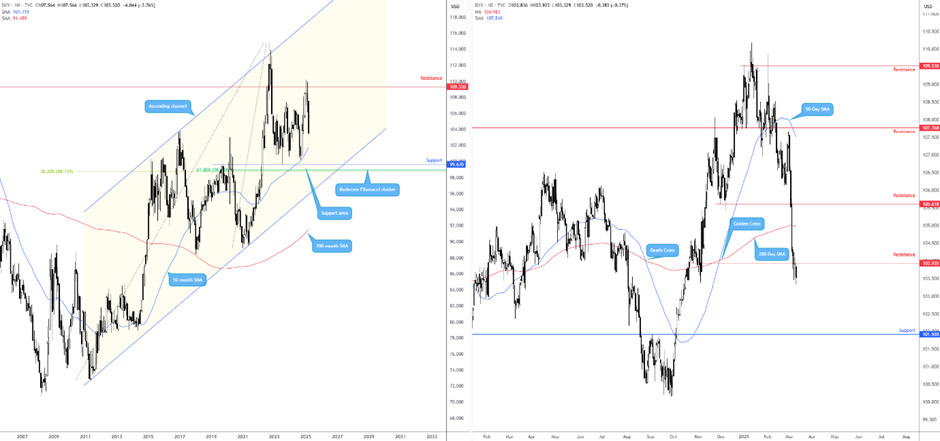Market participants will closely monitor February’s CPI inflation report (Consumer Price Index), scheduled to be released tomorrow at 12:30 pm GMT. The consensus anticipates that headline and core metrics will demonstrate signs of cooling.
Economists anticipate that year-on-year CPI inflation has eased to 2.9% (down from 3.0% in January) and that core inflation has cooled to 3.2% (from 3.3% in January). Between January and February, month-on-month headline inflation is expected to have slowed to 0.3% (down from 0.5%), with the core reading also forecast to cool to 0.3% (from 0.4%).
Most will probably agree that US President Donald Trump’s back-and-forth on tariffs is challenging to keep track of, and the uncertainty is impacting risk assets. Last Tuesday, the US administration imposed levies on three of America’s largest trading partners: Canada, Mexico, and China, only to see some goods exempted the following day (for one month), with additional items added to the exempted list on Thursday of the same week. During an interview with Fox News on Sunday, uncertainty mounted when Trump sidestepped whether he was expecting a recession this year, stating ‘he hates to predict things like that’ and adding that there would be a ‘period of transition’. As a result of tariffs enforced in February, this week’s CPI inflation release could be a turning point. Although tariffs did not take effect in February (except for China), given the 30-day reprieve, businesses have been preparing to bear tariffs by raising prices. Both the ISM (Institute for Supply Management) manufacturing and services PMIs (Purchasing Managers’ Indexes) showed that the prices paid sub-indexes pushed higher. While the ISM manufacturing index dropped to 50.3 from January’s reading of 50.9 – along with the employment and new orders indexes dipping into contractionary territory to 47.6 and 48.6, respectively – the prices paid index surged to the upside, coming in at 62.4 from 54.9 in January. If this week’s report indicates rising price pressures, I believe this presents a noteworthy upside risk to inflation, potentially influencing rate pricing, which may result in a bid in US Treasury yields and the US dollar (USD).
Fed unlikely to move based on February’s CPI print
Should data report as expected, although this would mark signs of cooling inflation, it provides the US Federal Reserve (Fed) with little incentive to begin easing policy at this juncture given the current uncertainty ahead.
According to market pricing, this month’s meeting (19 March) will unlikely see any rate adjustment; investors currently have their eye on June’s meeting for the next 25 basis point (bp) cut (-34 bps). As a note, Fed speak will be limited until the next meeting as the central bank limits the extent to which Fed officials speak publicly – known as the ‘blackout period’.
Nevertheless, Fed Chairman Jerome Powell made the headlines on Friday. Speaking at the University of Chicago Booth School of Business Monetary Policy Forum in New York, Powell reiterated that the Fed is not in a rush to cut rates, commenting: ‘Our current policy stance is well positioned to deal with the risks and uncertainties that we face in pursuing both sides of our dual mandate’.
Precipitous USD decline
As per the US Dollar Index, the USD is down nearly 4% this month, and, according to the monthly chart, sellers could strengthen their grip at least until reaching the 50-month simple moving average at 101.72. A similar picture is seen on the daily chart following the breach of support from 103.94 (now marked resistance); an absence of support is reasonably clear until 101.92, levels not seen since October 2024. So, given the lack of support on the bigger picture, any pullbacks will likely be sold into until price action reaches possible support between 101.72 and 101.92.
Lower-than-expected data, of course, would likely support USD downside and see investors increase rate cut bets, though should data surprise to the upside, this could see an unwind in short positions (note that positioning is also relatively overstretched to the downside) as traders seek mean-reversion strategies. On the other hand, although a short-term burst to the upside could be seen, this may be tricky as an increase in price pressures could also stimulate stagflation concerns.
Charts created using TradingView
This material on this website is intended for illustrative purposes and general information only. It does not constitute financial advice nor does it take into account your investment objectives, financial situation or particular needs. Commission, interest, platform fees, dividends, variation margin and other fees and charges may apply to financial products or services available from FP Markets. The information in this website has been prepared without taking into account your personal objectives, financial situation or needs. You should consider the information in light of your objectives, financial situation and needs before making any decision about whether to acquire or dispose of any financial product. Contracts for Difference (CFDs) are derivatives and can be risky; losses can exceed your initial payment and you must be able to meet all margin calls as soon as they are made. When trading CFDs you do not own or have any rights to the CFDs underlying assets.
FP Markets recommends that you seek independent advice from an appropriately qualified person before deciding to invest in or dispose of a derivative. A Product Disclosure Statement for each of the financial products is available from FP Markets can be obtained either from this website or on request from our offices and should be considered before entering into transactions with us. First Prudential Markets Pty Ltd (ABN 16 112 600 281, AFS Licence No. 286354).
Recommended Content
Editors’ Picks

EUR/USD holds losses near 1.1350 ahead of ECB policy decision
EUR/USD stays on the back foot near 1.1350 in European session on Thursday. The pair loses ground on the back of a broad US Dollar rebound and as traders turn cutious ahead of the European Central Bank interest rate decision and Lagarde's press conference.

Gold price remains on the defensive below all-time peak amid positive risk tone
Gold price enters a bullish consolidation phase after hitting a fresh all-time peak on Thursday. A modest USD bounce and a positive risk tone cap the commodity amid overbought conditions. US-China trade war concerns, recession fears, and Fed rate cut bets support the XAU/USD pair.

GBP/USD stays offered below 1.3250 as US Dollar attempts a bounce
GBP/USD stays under pressure below 1.3250 in Thursday's European trading, snapping its seven-day winning streak. A tepid US Dollar recovery amid risk appetite prompts the pait to pullback from a six-month high of 1.3292 reached on Wednesday. Traders look to tariff headlibnes and US data for fresh impetus.

RAY sees double-digit gains as Raydium unveils new Pumpfun competitor
RAY surged 10% on Wednesday as Raydium revealed its new meme coin launchpad, LaunchLab, a potential competitor to Pump.fun — which also recently unveiled its decentralized exchange (DEX) PumpSwap.

Future-proofing portfolios: A playbook for tariff and recession risks
It does seem like we will be talking tariffs for a while. And if tariffs stay — in some shape or form — even after negotiations, we’ll likely be talking about recession too. Higher input costs, persistent inflation, and tighter monetary policy are already weighing on global growth.

The Best brokers to trade EUR/USD
SPONSORED Discover the top brokers for trading EUR/USD in 2025. Our list features brokers with competitive spreads, fast execution, and powerful platforms. Whether you're a beginner or an expert, find the right partner to navigate the dynamic Forex market.
